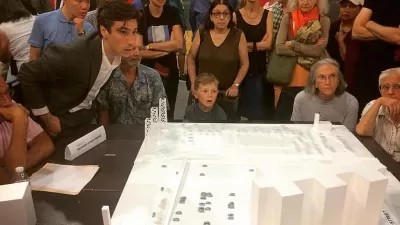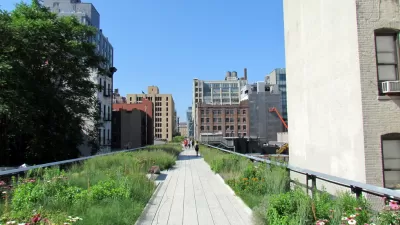Economic crises tend to manifest themselves in specific design trends, especially in the field of architecture. This latest recession has spurred the age of Do-It-Yourself architecture and urbanism.
In the first part of a four-part series for Places, Mimi Zeiger looks at how the trend of DIY urbanism is playing out.
"Our current recession is inspiring its own strategies and tactics: It's increasingly a catch-all for a host of urban interventions. This is a trend that I like to describe with a mouthful of a title: Provisional, Opportunistic, Ubiquitous, and Odd Tactics in Guerilla and DIY Practice and Urbanism. With this verbaciousness, I hope to capture the tactical multiplicity and inventive thinking that have cropped up in the vacuum of more conventional commissions. These days vacant lots offer sites for urban farming, mini-golf, and dumpster pools. Trash recycles into a speculative housing prototype (see the Tiny Pallet House). Whether it's The Living's Amphibious Architecture or Mark Shephard's Serendipitor, the built environment speaks through mobile devices. Retail spaces hit by the recession are fodder for reinvention, as the art organization No Longer Empty transforms unleased storefronts into temporary galleries. Even the street itself is reclaimed. REBAR's annual initiative, Park(ing) Day, urges global participants to use a pranksters wit to turn parking spaces into pocket parks, one quarter at a time."
FULL STORY: The Interventionist's Toolkit

Manufactured Crisis: Losing the Nation’s Largest Source of Unsubsidized Affordable Housing
Manufactured housing communities have long been an affordable housing option for millions of people living in the U.S., but that affordability is disappearing rapidly. How did we get here?

Americans May Be Stuck — But Why?
Americans are moving a lot less than they once did, and that is a problem. While Yoni Applebaum, in his highly-publicized article Stuck, gets the reasons badly wrong, it's still important to ask: why are we moving so much less than before?

Research Shows More Roads = More Driving
A national study shows, once again, that increasing road supply induces additional vehicle travel, particularly over the long run.

Judge Halts Enforcement of Anti-Homeless Laws in Grants Pass
The Oregon city will be barred from enforcing two ordinances that prosecute unhoused residents until it increases capacity and accessibility at designated camping sites.

Advancing Sustainability in Los Angeles County Schools
The Los Angeles County Office of Education’s Green Schools Symposium brings together educators, students, and experts to advance sustainability in schools through innovative design, climate resilience strategies, and collaborative learning.

Using Old Oil and Gas Wells for Green Energy Storage
Penn State researchers have found that repurposing abandoned oil and gas wells for geothermal-assisted compressed-air energy storage can boost efficiency, reduce environmental risks, and support clean energy and job transitions.
Urban Design for Planners 1: Software Tools
This six-course series explores essential urban design concepts using open source software and equips planners with the tools they need to participate fully in the urban design process.
Planning for Universal Design
Learn the tools for implementing Universal Design in planning regulations.
City of Moreno Valley
Institute for Housing and Urban Development Studies (IHS)
City of Grandview
Harvard GSD Executive Education
NYU Wagner Graduate School of Public Service
City of Cambridge, Maryland
Newport County Development Council: Connect Greater Newport




























